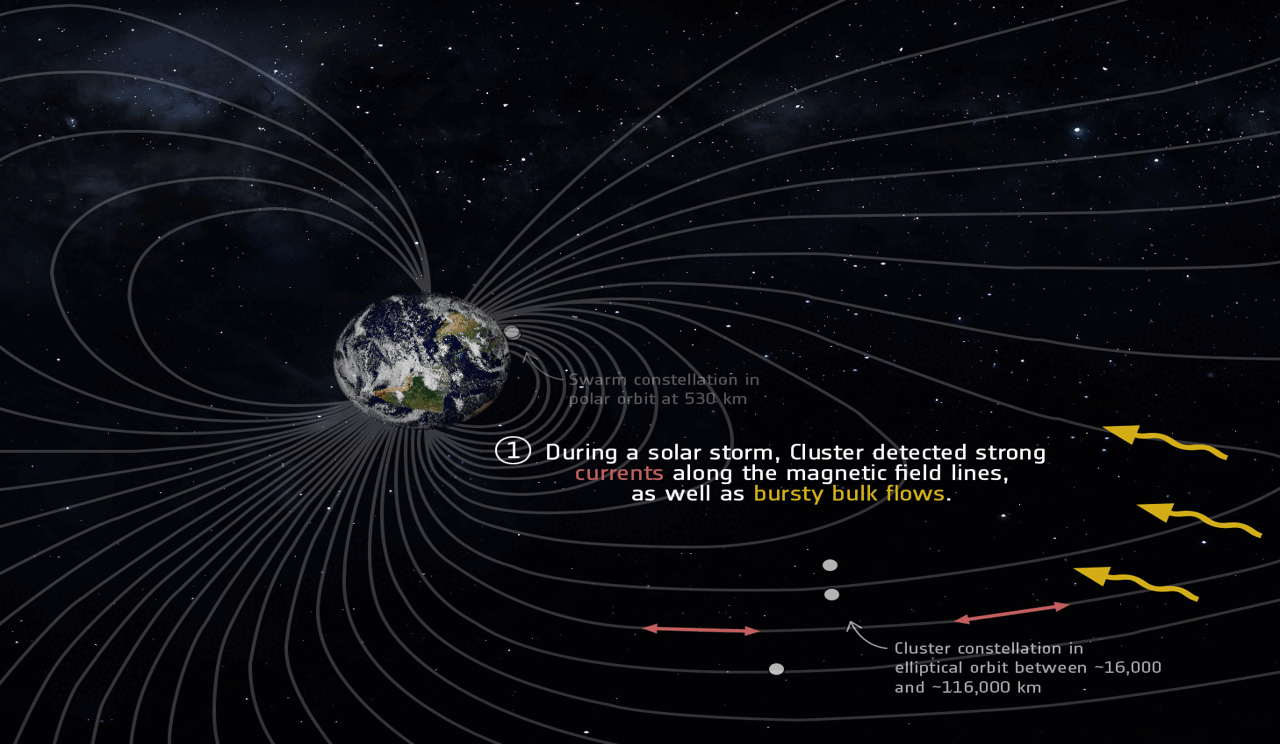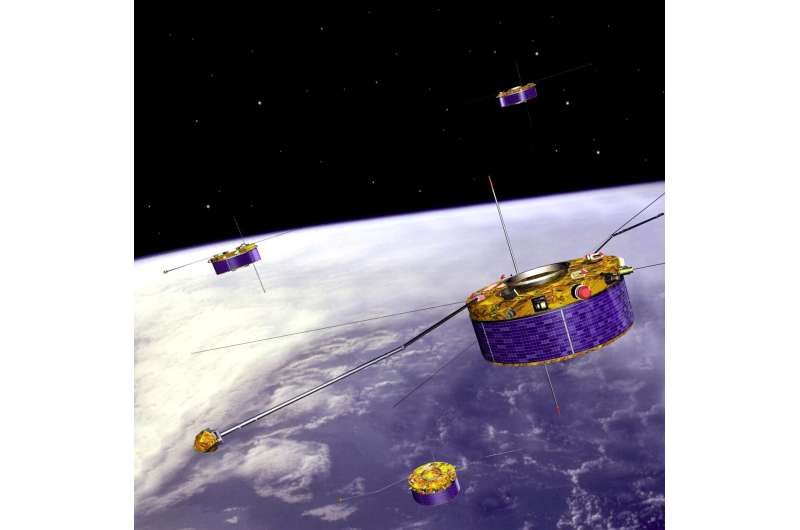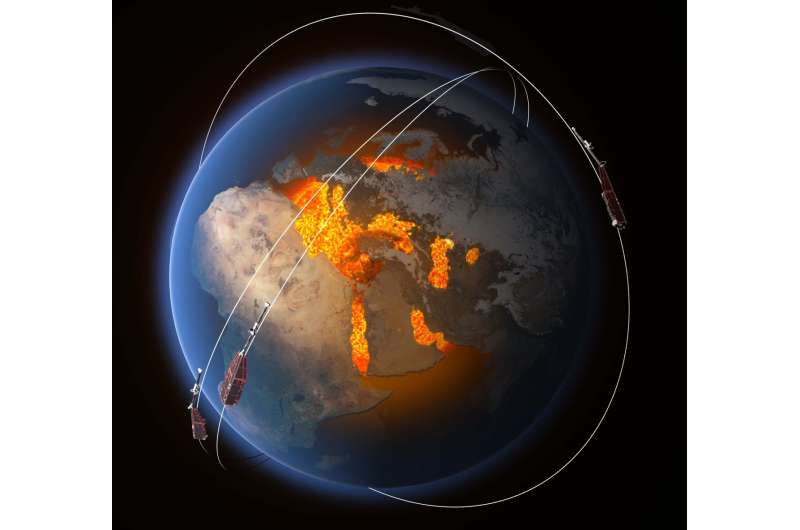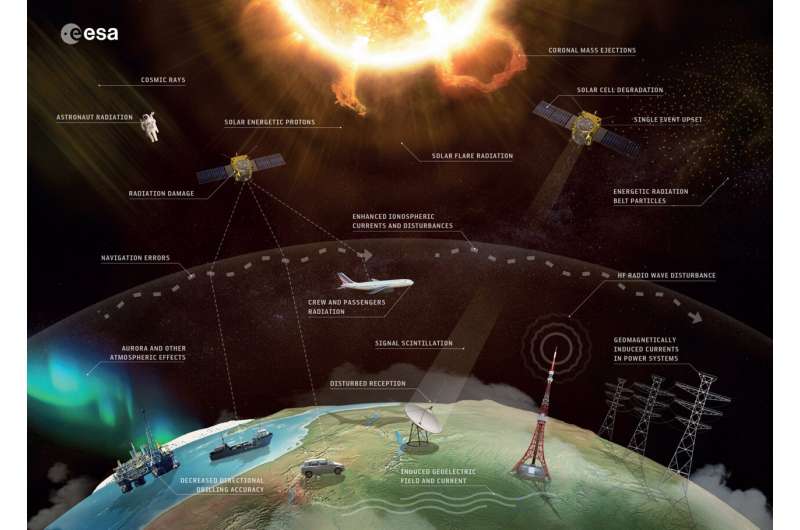Bursty bulk flows linked to magnetic field perturbations near Earth. Credit: European Space Agency
The notion of living in a bubble is usually associated with negative connotations, but all life on Earth is dependent on the safe bubble created by our magnetic field. Understanding how the field is generated, how it protects us and how it sometimes gives way to charged particles from the solar wind is not just a matter of scientific interest, but also a matter of safety. Using information from ESA's Cluster and Swarm missions along with measurements from the ground, scientists have, for the first time, been able to confirm that curiously named bursty bulk flows are directly connected to abrupt changes in the magnetic field near Earth's surface, which can cause damage to pipelines and electrical power lines.
The magnetosphere is a teardrop-shaped region in space that begins some 65,000 km from Earth on the day side and extends to over 6,000,000 km on the night side. It is formed through interactions between Earth's magnetic field and supersonic wind flowing from the Sun.
These interactions are extremely dynamic and comprise complicated magnetic field configurations and electric current systems. Certain solar conditions, known as space weather, can play havoc with the magnetosphere by driving highly energetic particles and currents around the system, sometimes disrupting space-based hardware, ground-based communication networks and power systems.
In an elliptical orbit around Earth, up to 100.000 km away, ESA's unique four-spacecraft Cluster mission has been revealing the secrets of our magnetic environment since 2000. Remarkably, the mission is still in excellent health and is still enabling new discoveries in the field of heliophysics—the science examining the relationship between the Sun and bodies in the Solar System, in this case, Earth.
The Cluster mission comprises four satellites flying in a tetrahedral formation and collecting the most detailed data yet on small-scale changes in near-Earth space, and on the interaction between the charged particles of the solar wind and Earth's magnetosphere. Credit: ESA—CC BY-SA 3.0 IGO
Launched in 2013, ESA's trio of Swarm satellites orbit much closer to Earth and are used largely to understand how our magnetic field is generated by measuring precisely the magnetic signals that stem from Earth's core, mantle, crust and oceans, as well as from the ionosphere and magnetosphere. However, Swarm is also leading to new insights into weather in space.
The complementarity of these two missions, forming part of the ESA Heliophysics Observatory, gives scientists a unique opportunity to dig deep into Earth's magnetosphere and further understand the risks of space weather.
In a paper published in Geophysical Research Letters, scientists describe how they used data from both Cluster and Swarm along with measurements from ground-based instruments to examine the connection between solar storms, bursty bulk flows in the inner magnetosphere and perturbations in the ground level magnetic field which drive 'geomagnetically induced currents' on and below Earth's surface.
The magnetic field is thought to be largely generated by an ocean of superheated, swirling liquid iron that makes up Earth’s the outer core 3000 km under our feet. Acting like the spinning conductor in a bicycle dynamo, it generates electrical currents and thus the continuously changing electromagnetic field. Other sources of magnetism come from minerals in Earth’s mantle and crust, while the ionosphere, magnetosphere and oceans also play a role. ESA’s constellation of three Swarm satellites is designed to identify and measure precisely these different magnetic signals. This will lead to new insight into many natural processes, from those occurring deep inside the planet, to weather in space caused by solar activity. Credit: ESA/ATG Medialab
The theory was that intense changes in the geomagnetic field driving geomagnetically induced currents are associated with currents flowing along the magnetic field direction, driven by bursty bulk flows, which are fast bursts of ions typically traveling at more than 150 km per second. These field-aligned currents link the ionosphere and magnetosphere and pass through the locations of both the Cluster and Swarm. Until now this theory had not been confirmed.
Malcolm Dunlop, from the Rutherford Appleton Laboratory in the UK, explained, "We used the example of a solar storm in 2015 for our research. Data from Cluster allowed us to examine bursty bulk flows—bursts of particles in the magnetotail—which contribute to large-scale convection of material towards Earth during geomagnetically active times, and which are associated with features in the northern lights known as auroral streamers. Data from Swarm showed corresponding large perturbations closer to Earth associated with connecting field-aligned currents from the outer regions containing the flows.
"Together with other measurements taken from Earth's surface, we were able to confirm that intense magnetic field perturbations near Earth are connected to the arrival of bursty bulk flows further out in space."
Magnetic reconnection in Earth's magnetosphere. Credit: ESA/ATG medialab
ESA's Swarm mission manager, Anja Strømme, added, "It's thanks to having both missions extended well beyond their planned lives, and hence are having both missions in orbit simultaneously, that allowed us to realize these findings."
While this scientific discovery might appear somewhat academic, there are real benefits for society.
The Sun bathes our planet with the light and heat to sustain life, but it also bombards us with dangerous charged particles in the solar wind. These charged particles can damage communication networks and navigation systems such as GPS, and satellites—all of which we rely on for services and information in our daily lives.
As the paper discusses, these storms can affect Earth's surface and subsurface, leading to power outages, such as the major blackout that Quebec in Canada suffered in 1989.
Space weather refers to the environmental conditions in space as influenced by solar activity. Credit: ESA/Science Office, CC BY-SA 3.0 IGO
With a rapidly growing infrastructure, both on the ground and in space, that supports modern life, there is an increasing need to understand and monitor weather in space to adopt appropriate mitigation strategies.
Alexi Glover, from ESA's Space Weather Office, said, "These new results help further our understanding of processes within the magnetosphere which may lead to potentially hazardous space weather conditions. Understanding these phenomena and their potential effects is essential to develop reliable services for end users operating potentially sensitive infrastructure."
More information: Dong Wei et al, Intense dB/dt Variations Driven by Near‐Earth Bursty Bulk Flows (BBFs): A Case Study, Geophysical Research Letters (2021). DOI: 10.1029/2020GL091781
Journal information: Geophysical Research Letters
Provided by European Space Agency


























